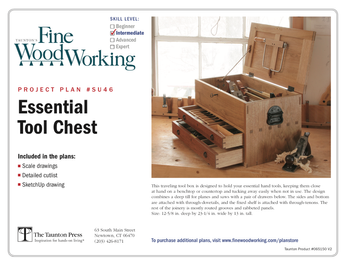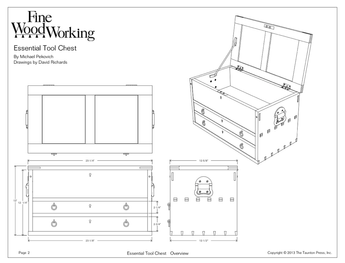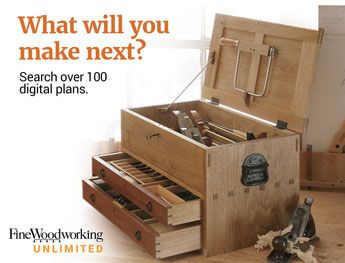Hello all,
While researching which tablesaw to purchase, I’ve come across a few people who say to just get a bandsaw instead. Some feel that with a good fence set-up you can do all of your ripping and cross-cutting on a band saw and then us a router table for dado, slots, etc. I have to agree that a bandsaw should be safer than a table saw. I think you would have to really try to loose more than a finger, and kickback is not as much of an issue. Any opinions?
Yes, I did a search of the archives and found some info, but I thought if I started a thread on the subject, it would help pull all the pros and cons on this subject into one place.
Thanks for your time.
Scott
outside!















Replies
I've heard that as well. Maybe if I was more "in tune" with my bandsaw I might agree with them. In my mind the challenge would be when you want to rip something that exceeds the throat capacity of your bandsaw. Also, what if I needed a 3" wide board, 48" long? I just spent Saturday tuning up my tools and installing and squaring a tall, new face on my tablesaw rip fence. When accuracy is critical, I can now use featherboards and hold down rollers and rip a board to any width that is within a few thousands of an inch from perfect. Even if the bandsaw could match that, I'd be left with a very rough surface that'd need to be smoothed out. You'll need to remove at least 1/32" of material to remove the milling marks left by the bandsaw. In my example above, you'd be forced to rip the board to 3 1/32" on the bandsaw, then carefully smooth out the mill marks with a handplane, jointer, sander, or some other method. On the tablesaw, I just rip it to width. The resulting mill marks are negligible.
A recent project got me thinking about accuracy. I'm making a through dovetail jig and needed precisely machined fingers that are 1.5" wide, and 6" long. They have to be perfect or the jig won't function correctly. It's tough to get that kind of precision out of a bandsaw.
Regards,
John
I remember reading an article by a guy once, who was claiming that the first serious piece of stationary power equipment a woodworker should get is a bandsaw. I would agree, but only provided that the woodworker is equipped with a good bench, the necessary kit of good bench tools (planes, chisels, etc.), and some essential portable power tools, such as but not limited to a circular saw, router, and drill/driver.
My son just bought a new house, so I loaned him my table saw so he could add in cabinets, etc. It's been over two months now, and I must say that I haven't missed it one bit. Doing cutoff's on long boards on the BS is a challenge, but with a little waste and an end support, it can be done. After ripping, i use the jointer to get a smooth edge. With the 1/2". 3 tpi blade from Timberwolf, ripping is as fast, or faster with 8/4 stuff, than the table saw. Sure like the additional space too!
PlaneWood by Mike_in_Katy
PlaneWood
At last! Someone else who appreciates the band saw for ripping and cross cutting. It takes a little while to shift gears and understand the differences in methods of work.
The band saw is so "calm" compared to the table saw.
But the band saw can't replace the circular saw completly, see, I have these large plywood panels I need to cut . . . !
R
Ahhhh, someone else who appreciates the "personality" of the band saw. Now, don't get me wrong, you'd have to drag my Jet CS away from me over my dead body, but there's something almost meditative about working on the band saw. So steady, relatively quiet, methodical, never wanting to throw things at the operator. I do enjoy it! Actually, the drill press is very similar. The two Zen tools in my shop, co-exisiting with all those uncivilized mega-rpm heathens.forestgirl -- you can take the girl out of the forest, but you can't take the forest out of the girl ;-)
Jamie; if you want a nice quiet,soothing power tool you must start using your scroll saw more often.. it is sooo relaxing, thats why Im such a mellow guy here <G>.. try it and you will agree.so find yourself a nice pattern and start mellowing out!! Just orders from your Doc..LOL.........
Happy Scrolling... ToolDoc
Scott -
I was one who you might have read saying, given a choice between the two and only one choice, I'd pick the bandsaw. But it depends entirely on what you want to do in your shop. I've gotten really interested in lathe work and it's pretty hard to cut out a round bowl blank on a table saw - safely at least.
You can cut mortises on a bandsaw safer than on a table saw. You can rip thicker stuff on a band saw than on a table saw. Properly tuned and with the right blade you can get really smooth finishes with a bandsaw. Not as perfect as with a table saw, no, but pretty close. I use Lennox carbide tipped blades in a Delta 14" bandsaw and have been truly impressed with what it will do. But this came at the cost of aligning the wheels so they are co-planar, making sure I adjust the fence for blade drift, and so forth.
I don't have a really good set of dado blades for my table saw and probably won't invest in any since I prefer to cut these with the router. In fact, I've taken to cutting angled joints along the long edges of stock with a router in a router table. I have a pretty good compound miter saw that would suffice for crosscutting and for panel sawing, a good portable circular saw and straightedge is actually easier to handle than a full sheet of plywood on a table saw.
But - as you can surmise, there are trade-offs with everything. If I could only have the one between a bandsaw and table saw, I'd pick the bandsaw. But I'd also pick a router, portable circular saw and miter saw to pick up the slack from the loss of the table saw.
But I think I'd still be money ahead if we're talking high end cabinet saw.
woodnut@anatechsys.com
Dennis,
"You can cut mortises on a bandsaw safer than on a table saw."
You mean tenons, right?
R
> .....You mean tenons, right?
Yeah.... you can tell how much cabinet work I've done (sheepish grin)
Dennis in Bellevue WA
woodnut@anatechsys.com
Let me tell ya. Cutting motises on the bandsaw is HARD!
R
> ....
Let me tell ya. Cutting motises on the bandsaw is HARD!
......
Well, it couldn't be much harder than cutting raised panels on a band saw, could it? (grin)
Dennis in Bellevue WA
woodnut@anatechsys.com
I hear they're equally challenging.
But I do all my pattern cutting on the jointer. Never go with the flow. Just an iconoclast that's me!
R
Interesting discussion!
Things get a little crazy when one insists on either or, don't you think?
I have both table and band saw, actually I have two of each, why? Because each of them do things the others cannot, things I want to do.
If you can afford to start with whatever you want, that is one thing, but if you must grow your passion for wood out of a small pittance allowance because of the cost of living, then you get creative and see how much you can do with less.
It is amazing what a person can do with a good portable circular saw carefully mounted under a piece of good plywood, mounted on a couple saw horses and a table mounted router to clean up the edges.
But as you grow your shop, a table saw is about as basic as one can get, next a jointer/thicknesseer, then a bandsaw. I love my Shop Smith which I use because of its variable speed and drill press, not to mention disc and inflatable drum sander, did I mention polisher?
I notice as I have observed wood craftsmen all over the USA, that their work is affected by their physical size, and the kinds of tools they have available. Krenov's work is great, but really small scale.
I am amazed at all the new tool ideas being churned out by creative people.
No matter how one accomplishes the design and assembly of a fine piece of woodcraft, there is something warm and wonderful about the touch of an insightful, resourceful, and may I say artistic human hand turning a branch, log or stick of firewood into a useful object of wood.
Good points Ted.
R
Hey Ted,
You have the right attitude for a woodworker.
Just go with the flow.The proof is in the puddin'
Seems to me that a good buy is the issue. As PlaneWood said, you will also need a jointer to get a good edge. As Dennis said, you will need a router, circular saw, and miter saw to make up for the versatility of the table saw. How much money are you willing to spend on the first major tool(s)? As a first tool I bought a table saw. Yes it is more dangerous than a band saw but at the same time it will let you do some things the band saw alone can't. Don't take me wrong, I could not work in my shop without my band saw, but it was not the first tool in my shop. If you invest on a closed stand, inboard motor, belt driven table saw with some zero-clearance inserts, a dado blade and a good fence, you could do just about anything.
Another point for the table saw is that it does not need all of the tunning up the band saw requires. It takes some time to get used to the workings of the band saw - you can't just turn it on and expect to get straight cuts. Nothing is more frustrating than barrel cuts, breaking blades, damaged bearings, miss-aligned wheels, etc. A good book is in order to help you understand the principles behind the parts.
Resawing boards and cutting curves will always be a problem with the table saw, but by the time you are ready to do this hopefully you would have saved up for a band saw - the next must-have tool.
Cutting curves on the table saw is easy, if you have the right machine!
(I'm thinking of a very popular model of contractor's saw I once owned sold by a very popular national chain. Notice that I didn't mention Craftsman or Sears; don't want to start anything.)
Jeff
I'd be scared to try. The only ones i'd be confortable are running the stock at an angle, with a shaper blade, and getting a cove cut. Other than that, I am not too sure.
DON'T TRY IT!!! I was being a smart a _ _. My old saw just wouldn't cut straight.
Jeff
I guess a lathe would be the most logical first choice for a shop machine. You could chuck a 5/8" arbor in the thng, mount a blade and do a lot of sawing. Maybe that's what the Shop Smith guy thought of (grin)
No, I'm not about to give it another thought!!!
Dennis in Bellevue WA
woodnut@anatechsys.com
Keep thinking, Dennis; you may be on to something.
Jeff
Dennis,
Great idea. You could mount 2 or 3 blades in a rotating thingy and do planing or jointing. And drilling. You could do that. And sanding. Mortising. I think you're on to something!
R
This topic seems to come up all over, but it always interests me.
First off, I'm probably in the bandsaw camp. Whenever I need a tablesaw, I go to a local college where I know the shop manager (where one time a girl 'taught' me how to cut a curve on the tablesaw; I stopped her in time)
Anyway, I think the tablesaw is the obvious choice (between the two anyway) if you are dealing with a lot of plywood. I don't think the bandsaw is the best choice for crosscutting long boards, and using the sled on the tablesaw can be handy.
I think the bandsaw is a machine that requires more knowledge to use. With the tablesaw, you need to know safety first, and if you do things safely, it will be good. With the bandsaw you need to know about a lot more things.
Also, I don't think the quality of cut from a bandsaw is all that bad. If you have a nice bandsaw that can acheive proper tension on your blade, and you use the right blade, the cut can be pretty clean. Not as clean as a good tablesaw, but better than a bad tablesaw.
Tom
cutting curves on the tablesaw is easy and safe if you know how to do it. I've cut perfect circles on a tablesaw before without doing anything too dangerous. you cut them by raising the blade little by little while you spin a piece of wood around a nail or screw which acts as the center of your circle. it's the same principle that makes cutting coves on the tablesaw possible.
I know what you meant though, I've seen some people do some pretty stupid things as well.
I recently thought I lost the motor on my table saw and had no way to get the part I thought was needed, (it only turned out to be the centrifugal switch which could be fixed with a little scrap plastic, way too much effort went into figuring this out) this forced me to do all of my ripping on the bandsaw. I have to say I was surprised how well it cut, in the past I had only run curves with it and then always had to clean up the cut. But I can do without the setup, accounting for drift and resetting the guides, etc., The ease/speed of use and variety of cuts it is capable of make the table saw a must have tool.
This discussion falls into the 'what type of work you do' category. For some it would be difficult to get by without a table saw for others its the bandsaw, you have to answer that question for yourself. Now if someone asked 'I want to make this and that' I feel it would be possible to make a useful recommendation.
By the way, how do you cross cut on a bandsaw ? I can only think of one way and it would require three cuts to get two square ends.
Michael
<snip>
By the way, how do you cross cut on a bandsaw ? I can only think of one way and it would require three cuts to get two square ends.
<snip>
That's the only way I can think of; at least with boards longer than the cut capacity. I wouldn't do this on a bandsaw unless my miter saw was broken and all my handsaws were stolen.
Tom
If I ever went back to doing commercial cabinets, I think I could get by without a table saw. I would have - Panel saw, jointer, planer, band saw, shaper, and a cutoff saw. Don't think I would need a table saw at all.
PlaneWood by Mike_in_KatyPlaneWood
Thanks to everybody for the replies. I have learned a lot. I think for my purposes (making furniture and cabinets for the new addition that is full of strange angles) a tablesaw may be the best tool. I will have to see what the budget allows once the addition is finished. If I am limited to $600 I will probably get a Jet contracter saw. If I can spend more, I am looking at the Jet Supersaw with sliding table, or the Grizzley cabinet saw. Hmmm
Once again, thanks to all who replied.
Scott
This forum post is now archived. Commenting has been disabled